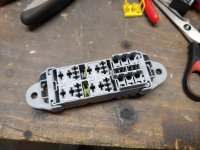Last weeks ive been working on the seat, the electronics and the final details.
Spend quite alot of time finding the right kind of foam. And determining the thickness and shape. Really hard and time will tell if the ergonomics have been improved.
The upholstery guy did a nice job on the cover!
After that I spend most of the time on the electronics. Something I'm not the biggest fan of. I did a lot of research about the way they wire racing cars, aviation and military specifications. Some how I find that really interesting.
If you are interested here is a great source of information:
https://www.rbracing-rsr.com/wiring_ecu.html
My goals here are:
- completely new loom.
- highest spec. For normal money
- no soldering unless I have no other option. I did everything with open barrel crimp splices because they offer the most reliable connection.
- document everything
I considered going for an M-unit but found it to expensive, thinking I could save money just buying separate components like wires, terminals, connectors and relays.
Turns out this was quite more expensive than I would have thought. Doing it again I probably would go for an M-unit. Although I did learn tons from this!
First thing I did was spend quite some time with PowerPoint drawing the new schematic.
This is what I came up with. Please feel free to review this!!!
I wanted to add things like a horn and indicators because I really missed those. Secondly I wanted to run thing through relays because last year I had quite some issues with weird backflow stuff.
Next I got automotive grade wiring (mill. Spec I found to expensive), components like switching gear, shrink tubing, splice crimpers and tons more.






